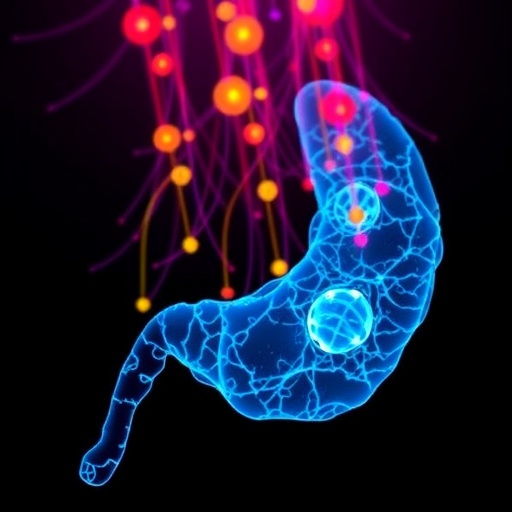In a significant advancement in cancer prognosis, recent research has elucidated the pivotal role of tumor metabolic heterogeneity (MH) assessed through 18-fluorine fluorodeoxyglucose positron emission tomography combined with computed tomography (^18F-FDG PET/CT) in predicting outcomes for patients with diffuse large B-cell lymphoma (DLBCL). This revelation not only deepens the understanding of the metabolic landscape of lymphoma but also sets a new paradigm for individualized treatment strategies.
Tumor metabolic heterogeneity, an indicator reflecting the variance in metabolic activity within tumor cells, has long been recognized as a hallmark of drug resistance in solid tumors. However, its prognostic relevance in hematologic malignancies such as DLBCL has remained largely uncharted until now. The meticulous study conducted by a team at the Third Affiliated Hospital of Soochow University systematically delineates this relationship through extensive retrospective analysis.
The study retrospectively reviewed clinical and imaging data from 297 DLBCL patients evaluated between August 2012 and December 2022. The comprehensive approach employed involved quantifying MH through the area under the curve of the cumulative standardized uptake value-volume histogram (AUC-CSH), a sophisticated metric derived from ^18F-FDG PET/CT scans. AUC-CSH captures the subtle variations in glucose uptake heterogeneity within tumors, offering a window into the complexity of tumor metabolism.
Additionally, traditional PET parameters, including maximum standardized uptake value (SUVmax), mean standardized uptake value (SUVmean), total metabolic tumor volume (TMTV), and total lesion glycolysis (TLG), were analyzed. These conventional markers provide essential yet sometimes limited insights into tumor biology. The integration of the AUC-CSH metric augments this landscape by unveiling intratumoral metabolic diversity, which conventional metrics might overlook.
Crucially, the research team employed Cox regression models to discern prognostic factors influencing progression-free survival (PFS) and overall survival (OS), two cornerstone outcomes for assessing therapeutic success in lymphoma. Their multivariable analysis identified age, TMTV, and AUC-CSH as independent predictors for both PFS and OS, underscoring the multifaceted nature of prognostication in DLBCL.
Of particular interest is the inverse relationship observed between AUC-CSH values and tumor MH; lower AUC-CSH corresponded to greater metabolic heterogeneity and, consequently, poorer survival outcomes. This insight provides a quantifiable biomarker for assessing tumor aggressiveness and potential treatment resistance, facilitating refined risk stratification.
The researchers further harnessed these variables to construct a prognostic model, which they benchmarked against the well-established National Comprehensive Cancer Network-International Prognostic Index (NCCN-IPI). Remarkably, their combined model demonstrated superior predictive power, highlighted by higher concordance indices (C-indexes) for both PFS and OS. This enhanced discrimination capability signifies a meaningful leap toward precision oncology.
Model calibration and decision curve analyses (DCA) substantiated the model’s predictive accuracy and its clinical utility in guiding individualized therapeutic decisions. Such validation is crucial when considering the translation of prognostic tools from research settings into routine clinical practice, where each patient’s treatment strategy can be optimized based on robust risk assessment.
The potential clinical implications of these findings are profound. Incorporating MH measurement via ^18F-FDG PET/CT could refine the prognostic landscape of DLBCL, enabling oncologists to identify high-risk individuals who might benefit from intensified treatment regimens or alternative therapeutic approaches. Conversely, it may spare low-risk patients from overtreatment, reducing toxicity and preserving quality of life.
Moreover, this approach exemplifies the growing trend of leveraging advanced imaging biomarkers to unravel tumor complexity beyond mere size and location. By dissecting metabolic heterogeneity, clinicians can better understand tumor biology, potentially uncovering novel therapeutic targets aimed at overcoming resistance mechanisms embedded within heterogeneous tumor niches.
This study also paves the way for future research probing the interplay between tumor metabolism and the immune microenvironment in DLBCL. Understanding how metabolic heterogeneity influences immune evasion or responsiveness to emerging immunotherapies could herald new avenues for combination strategies and precision treatment.
While the retrospective nature of this analysis inherently limits causality assertions, the rigorous methodology and substantial cohort size lend credence to these compelling findings. Prospective studies and external validations are warranted to consolidate the application of AUC-CSH-based prognostic models.
Ethical oversight and institutional approval were meticulously maintained, ensuring adherence to standards that safeguard patient data integrity and privacy—an essential aspect when harnessing retrospective imaging datasets.
This landmark research exemplifies the convergence of cutting-edge imaging technology and clinical oncology, heralding a future where tumor metabolic profiling becomes integral to lymphoma management. As ^18F-FDG PET/CT imaging continues to evolve, its utility transcends diagnostics, embodying a prognostic tool that empowers personalized medicine.
In summary, the study decisively establishes tumor metabolic heterogeneity—quantified through AUC-CSH on ^18F-FDG PET/CT—as a robust biomarker predictive of survival outcomes in DLBCL. The integration of this parameter with established clinical factors culminates in an improved risk stratification model, surpassing traditional indices and offering tangible clinical benefits.
This advancement underscores a pivotal shift toward embracing tumor heterogeneity in all its complexity, moving beyond one-dimensional metrics and towards multifactorial models that reflect the intricate biological realities of cancer. Ultimately, this may translate to more tailored and effective therapeutic interventions, improving survival and quality of life for patients grappling with diffuse large B-cell lymphoma.
The implications of this research resonate beyond lymphoma, hinting at the broader applicability of metabolic heterogeneity assessment in diverse oncologic settings. As the oncology community embraces precision diagnostics and personalized therapies, innovations such as these will be instrumental in shaping next-generation cancer care.
The journey from volumetric imaging to nuanced metabolic characterization signals a transformative era in oncology, where each pixel serves not just as an image, but as a repository of vital prognostic information guiding life-altering decisions.
The promise held by tumor metabolic heterogeneity analysis beckons ongoing exploration, collaborative validation, and eventual integration into clinical algorithms that define the future of cancer prognosis and treatment.
Subject of Research: Tumor metabolic heterogeneity assessed by ^18F-FDG PET/CT as a prognostic biomarker in diffuse large B-cell lymphoma (DLBCL).
Article Title: Tumor metabolic heterogeneity based on ^18F-FDG PET/CT is a predictor of outcome in diffuse large B-cell lymphoma.
Article References:
Xin, W., Wang, F., Lu, L. et al. Tumor metabolic heterogeneity based on ^18F-FDG PET/CT is a predictor of outcome in diffuse large B-cell lymphoma. BMC Cancer 25, 1807 (2025). https://doi.org/10.1186/s12885-025-15149-x
Image Credits: Scienmag.com
DOI: 10.1186/s12885-025-15149-x (Published 24 November 2025)
Keywords: Tumor Metabolic Heterogeneity, ^18F-FDG PET/CT, Diffuse Large B-Cell Lymphoma, Prognostic Biomarker, Metabolic Tumor Volume, Total Lesion Glycolysis, Survival Prediction Model, Cox Regression.
Tags: 18F-FDG PET CT imagingarea under the curve metriccancer metabolism researchclinical outcomes in lymphoma patientsdiffuse large B-cell lymphomadrug resistance in hematologic malignanciesglucose uptake variations in tumorsindividualized treatment strategieslymphoma prognosismetabolic activity in tumorsretrospective analysis of DLBCL patientstumor metabolic heterogeneity





